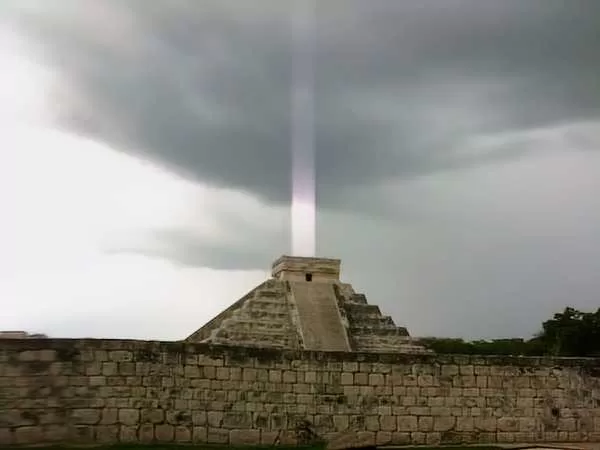In 2009, tourist Hector Siliezar’s trip to the ancient Mayan city of Chichen Itza took an extraordinary turn. While attempting to capture a dramatic lightning strike against the backdrop of El Castillo, a pyramid dedicated to the feathered serpent god Kukulkan, a different kind of light caught his eye.
Siliezar snapped three photos, each 15 seconds apart, the time it took for his iPhone camera to save the image. Upon reviewing the pictures, he was astonished to see a beam of light seemingly emanating from the pyramid’s peak. Was this a message from the gods, a sign of the apocalypse? Or something far more earthly?
The Intrigue Spreads
Excited by his discovery, Siliezar shared the photos with everyone around him, including Mayan priests who advised him to keep the images private. However, a celebrity tourist convinced him to show them to Jaime Maussan, a well-known Mexican UFO investigator.
The image first appeared on the Italian website Segni dal Cielo (“Signs from Heaven”), supposedly run by Massimo Fratini. Speculation arose that Fratini, or someone close to him, might be the original photographer based on a screenshot of the image’s file directory.
The plot thickened further when the original photos were reportedly sold to Maussan, who then distributed them to a Mexican TV channel. Maussan’s name, however, often appears coupled with the word “hoax” in online discussions surrounding the photo, highlighting the ongoing debate about its authenticity.
Light Fantastic or Technical Glitch?
The photo has fueled discussions in Mayan doomsday forums, with some interpreting the light beam as a divine message or a harbinger of the apocalypse. Others propose a more prosaic explanation – a simple glitch in Siliezar’s iPhone camera.
Demystifying the Light
So, what’s the truth behind the Mayan Light Beam photo? Unfortunately, there’s no definitive answer. The lack of raw, unedited images makes a thorough investigation challenging.
Here are some possibilities:
- Camera malfunction: A glitch in the camera’s sensor or software could have produced the light effect.
- Lens flare: Internal reflections within the lens, especially when pointed towards a bright light source, can create unusual visual artifacts.
- Photo manipulation: While less likely, the possibility of digital editing cannot be entirely ruled out.
Without access to the original, unedited photos, it’s impossible to definitively determine the cause of the light beam.
The Mystery Endures
Hector Siliezar’s photo continues to intrigue and spark debate. Whether it’s a glimpse into the supernatural or a technological quirk, the Mayan Light Beam photo serves as a reminder of the allure of the unknown and the power of images to capture the imagination.

